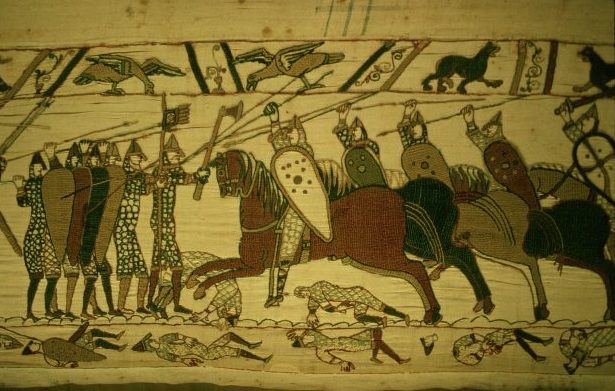Today is the most important date in our history, the day on which in 1066 thousands of men fought outside Hastings and England was changed forever. By the end of the day, 950 years ago, thousands were dead, among them England’s king, Harold II, and most of the country’s leaders.
As historian Elizabeth van Houts put it, ‘No other event in western European history of the central Middle Ages can be compared for its shocking effects: the carnage on the battlefield, the loss of life and the consequent political upheaval.’
In our minds the Normans have become sort of pre-eminent Hollywood upper-class English villains, blamed for long-standing class divisions in England. Norman ancestry is synonymous with elitism, so that French sounding names suggest privilege, while Anglo-Saxon ones appear humble. In the most popular British book and film series of recent years, the heroes have the very Anglo-Saxon sounding surnames Potter and Weasley, while the baddies go by the Normanesque Voldemort and Malfoy. It’s shorthand for humility vs privilege.
To take one example, when Gerald Grosvenor, the 6th Duke of Westminster, was asked by a journalist what advice he’d give to a young entrepreneur hoping to become rich, he suggested ‘make sure they have an ancestor who was a very good friend of William the Conqueror’. It was not entirely bad advice, for the duke’s forebear Hugh Lupus, ‘le gros veneur’, or chief huntsman, had indeed been granted lands by William in Cheshire in order to keep the Welsh under control. In the 1170s his descendent Robert le Grosvenor had been granted the manor of Budworth in the county, which is still home to the Grosvenor seat, the Eaton Estate. When the duke passed away this year he left £8billion to his son.
This division of the country between Normans and Saxons has long been a theme of English cultural and political life, one touched upon by Labour Party activist John O’Farrell in his 1999 book Things Can Only Get Better, when he wrote: ‘The Normans of Fulham still drank wine and owned land in France and the Saxons of Fulham still drank ale, used ‘Anglo-Saxon’ vocabulary and tended small strips of land behind the playing fields.’
O’Farrell was echoing Benjamin Disraeli’s Sybil, the 19th century novel of British class divisions which gave us the phrase ‘two nations’, and saw them as being literally the descendants of two different races who fought near Hastings. Another 19th century author, Walter Scott, did more than anyone else to present the Normans as perma-baddies with Ivanhoe, which told of a Saxon hero in 12th century England.
But back in the 17th century the leader of the Diggers, Gerrard Winstanley, saw his band of civil war radicals as inheritors of the English struggle against the Normans. In his crackpot pamphlet The New Law of Righteousness, which advocated a sort of Christian Communism, he argued that the Bible said everyone should be equal and that: ‘Seeing the common people of England by joynt consent of person and purse have caste out Charles our Norman oppressour, wee have by this victory recovered ourselves from under his Norman yoake.’ This wasn’t remotely true, of course – life for the poor in Saxon England was dreadful.
Later, American revolutionaries such as Thomas Jefferson would identify with the defeated of 1066, seeing themselves as descendants and political successors of Harold II’s men. Jefferson, a keen student of Anglo-Saxon history, proposed that one side of the seal of the United States feature Hengest and Horsa, the semi-mythological fifth century Jutish leaders who conquered Kent. Which would be extremely problematic today.
It’s true the Normans were ‘ferocious’, as William of Apulia put it. One Lombard prince, facing Norman warlords in southern Italy, described ‘a savage, barbarous and horrible race of inhuman disposition’. Even Henry of Huntingdon, half-Norman himself, said they ‘surpassed all other people in their unparalleled savagery’.
And they were certainly unwelcome rulers. The Anglo-Saxon Chronicles recorded that after 1066: ‘When the castles were built, they filled them with devils and wicked men… they levied taxes on the villages… they robbed and burned’. Women were subject to the sort of horrors one expects, as the Chronicles recorded: ‘noble maidens were exposed to the insults of low-born soldiers, and lamented their dishonouring by the scum of the earth’. By ‘insults’, of course, they were not talking about micro-aggressions.
The conquest was certainly disastrous for the native aristocracy. Those who survived Hastings were thrown off their land, and by the time of the Conqueror’s death just 5 per cent of England was owned by the natives, with between a third and half of the country shared out between 170 Norman barons, and the rest going to the king and the Church; there were just two English major landowners left. Many Englishmen instead fled to Scotland, where they helped to tip the linguistic balance away from Gaelic; others went to fight for the Byzantine Emperor in Constantinople while, stranger still, some established a colony in Crimea called New England.
The new Norman elite were vastly wealthy; according to a Sunday Times estimate, William’s half-brother Bishop Odo, who was given Kent and land in 22 counties, was worth £43.2 billion in today’s money, which would put him ahead of the most rapacious African kleptocrat. The conqueror’s other half-brother, Robert of Mortain, was worth £46.1 billion while William of Warenne a staggering £57.6 billion. The new king was richer still.
The English were also removed from the upper echelons of the Church, while English cults were suppressed, some of them never to reappear. By the end of William’s reign there was just one English bishop out of 16, and a decade later even he was gone. At Glastonbury Abbey in 1083, when English monks resisted a new Norman liturgy, soldiers fired arrows at them from choir loft, killing a number of them. The Chronicle recorded: ‘blood came down from the altar onto the steps and from the steps to the floor’.
The worst atrocity was the harrowing of the north, in which a local uprising was met with such vicious reprisals that anywhere between 100,000 and 200,000 people died. So out of control was William’s violence that one Norman knight went home to the continent in disgust, and it took something for a Norman to do that.
However, contrary to Winstanley’s fantasy, pre-Norman England was not an egalitarian paradise in the slightest. Over ten per cent of the adult population were slaves, rising to a quarter in some western regions, and it was in fact the Normans who abolished slavery, allowing people to rise up to serfdom (which admittedly wasn’t a fantastic life either). The Normans also introduced the idea of chivalry, which originally was just a way for young men to glorify violence but did come with the idea that aristocratic prisoners should be ransomed, not killed. Anglo-Saxon aristocrats would murder rivals at the drop of a hat, which is partly why the country was so divided by 1066.
The Normans also put up many great buildings. As Robert Tombs writes in his magisterial The English and Their History, Winchester cathedral was the longest in western Europe, the Tower of London the biggest keep in western Europe and Westminster Great Hall the largest secular covered space; while Christ Church priory in Canterbury probably took more cut stone than the pyramids. The Normans introduced the Romanesque style of stone building to England, where previously most had been wooden.
The economy also grew hugely in the late 11th and 12th century, and there was a big increase in trade with continental Europe, especially the export of wool, although this may also have happened anyway. There was also a rise in the number of monasteries, which were the main centres of learning before universities began to spring up; and teaching at Oxford first began in 1096, although it would be another century or so before continental-based orders such as the Dominicans and Franciscans turned it into the intellectual powerhouse it would become. Without all this England would have been freer, but also perhaps poorer, both economically and culturally.
So yes, what I’m saying basically is that the Normans were the cosmopolitan liberal elite of their day, the Remainers.
Coincidentally, remain is one of the thousands of words that have come to us from French, with between a quarter and half of all English words originating with our neighbours (although most came after the end of Norman rule, in the 13th and 14th centuries). Leave is good old Anglo-Saxon, just like the battle cry used on October 14, 1066 – ‘Uit!’ (out!).
But who can deny that our language has been enriched by French, thanks in part to William the Conqueror? Because of the Normans we have both friendship and amity, brotherhood and fraternity, motherhood and maternity, rise and ascend, cheer and cherish, cave and cavern, stand and stay, cow and beef, think and pensive, smell and odour, help and aid, weep and cry, weird and strange, harbour and port, worthy and valuable, and knowledge and science. If it wasn’t for the Normans we’d all be speaking German.







Comments